5.1 Determining Causes of Child Abuse
Different models and theories try to help us understand the causes of child abuse and, therefore, how to prevent it. There isn’t one theory that is the best or explains it all. Rimer and Prager (2016) discuss a combination of the following can help us understand what increases the risk and cause of child abuse:
- a caregiver’s potential to abuse, such as an abusive upbringing;
- the caregiver’s view of their child perhaps as difficult to care for, increasing risk;
- situations in the environment, such as low finances, and social situations, like domestic abuse.
This resource focuses mainly on Steele’s model of understanding abuse. Steele’s model considers how both the caregiver, their view of the child and the stressors play a role in abuse occurring but also how the absence or lack of engagement in supports impacts whether abuse actually occurs or not.
The more we can understand why child abuse happens, the better we are able to consider the possibilities to prevent child abuse.
Understanding risk
- Caregiver’s potential to abuse
- Caregiver’s view of the child
- Environmental and social factors (Rimer & Prager, 2016)
Background
Dr. Brandt F. Steele was an early pioneer in the research on understanding child abuse and neglect. He and Dr. C. Henry Kempe became the first to identify physical and psychological symptoms (signs) of child abuse by parents. Their work became one of the most important medical contributions to the Journal of the American Medical Association of the twentieth century (Brandt F Steele, 2005).
Steele’s work focused on figuring out why parents would abuse their children and what could be done to stop it. He was the first to document that people who abuse children were often abused or neglected as children themselves (Korbin & Krugman, 1987).
Steele’s key to his success was his belief that “if you don’t understand someone’s behaviour, you don’t have enough history.” He had infinite patience and compassion for all those who were abused—including all those who were now abusers. He believed in the efficacy of mental health treatment and multidisciplinary approaches to recognition and treatment. Child psychiatrist Ruth Kempe, the widow of Dr. Henry Kempe, also worked closely with Steele. Ruth Kempe said: “It was extremely fortunate for the field that Steele was the psychiatrist that began to see the parents and evaluate the families. Steele was able to see them not as traditional psychiatric patients but simply as distressed people who often, because of their own childhood history, had a particularly difficult problem with parenting. This approach enabled Henry Kempe and Steele to provide treatment programs that addressed the parents as much as the children. He knew that these parents were not villains and that they loved their children, they just didn’t know how to love them well” (Korbin & Krugman, 1987).
Steele developed a psycho-social model to:
- Understand the causes of abuse in a family situation
- Determine the risk of abuse
- Prevent further abuse
The model is consistently helpful today as we look at what went wrong and what we can do to support families to help prevent future child abuse and neglect.
Psycho-Social Model
The Psycho-Social model is a clinical theory with a focus on physical abuse, although it can help us understand other types of abuse. The model helps us learn about why the abuse happened (causes), which helps us understand and address the risk of further abuse.
Physical abuse to a child is different than a single incident of assault between two adults. When physical abuse occurs, there are dynamics within the family; there is a relationship between the child and the abuser. Police can’t just criminally charge and remove the perpetrator from the home and then legally consequence them as they would in other physical assault cases. As parents of the child, they will continue a relationship with the child and likely return to the home – which will again pose risk to the child if the dynamics of the physical abuse are not addressed. In stranger physical assault, the perpetrator can be released on condition not to associate with the victim.
One can’t just consider the incident that occurred in isolation but rather with other factors.
Do elements exist to suggest:
- the dynamics of abuse are present, and
- there is the risk the child will be harmed again.
Steele’s, Psycho-Social Model is a relevant framework when considering factors causing neglect. However, it is less likely that a neglectful parent will selectively neglect a child or a couple of children over others. In situations of neglect, the low quality of care provided by the parent to ALL the children is more consistent. Unlike physical abuse, where one child can be targeted over others in a family.
In determining whether an injury is the result of physical abuse, we consider Steele’s, Psycho-Social Model. The model identifies that maltreatment of children (abuse and/or neglect) can be attributed to the convergence of specific factors, and these factors, when combined, cause (contribute to) children being abused.
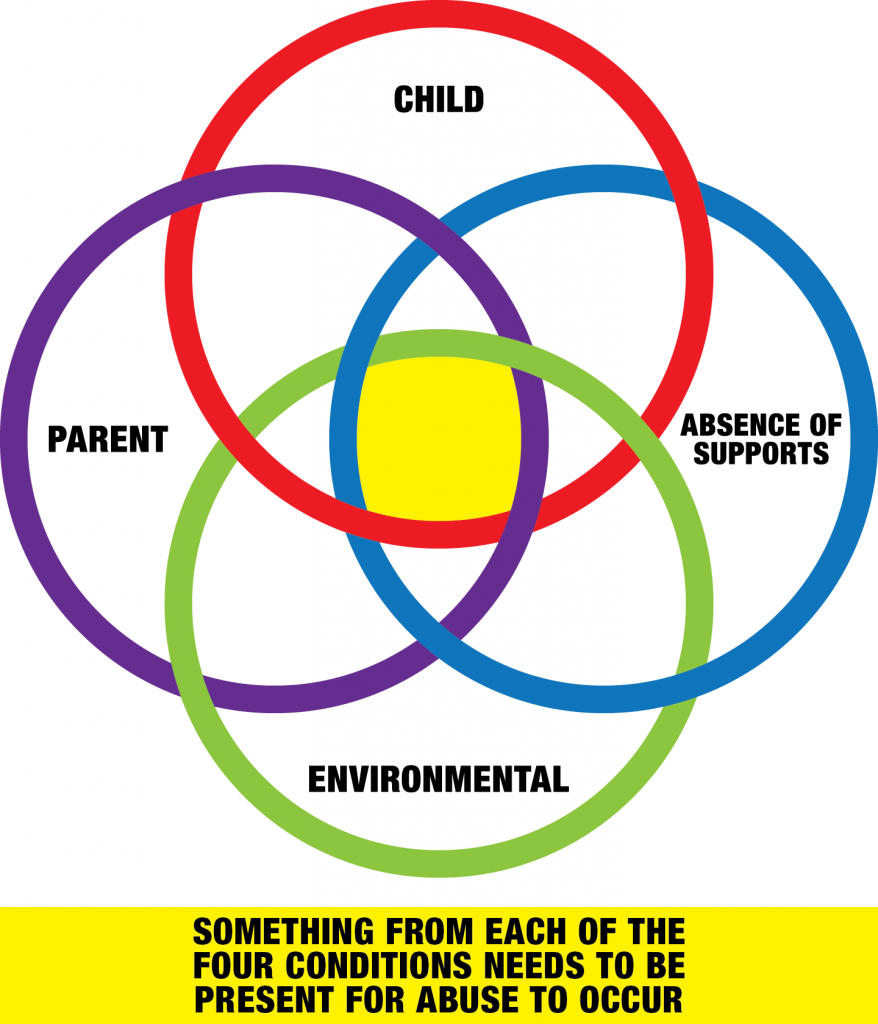
Steele identified the four conditions which are almost always present that played a role, when combined, caused (contributed to) children being abused.
- Parent factors related to risk
- Child factors related to risk
- Environmental factors related to risk
- The absence of supports, increasing risk
Steele theorizes that the child is abused due to several factors connected to each other and not in isolation. We know there is a person who abuses the child and a child who is the victim of abuse. Steele considered the dynamics within that relationship, the members of the family, what was happening in their home and around them and the support(s) available, and if so, were they willing to access it? When we take each of these in isolation, one cannot predict the risk of abuse. When Steele considered the factors that were going on together, the risk of abuse became apparent.
For example, a caregiver may have experienced childhood abuse and have low frustration tolerance (Parent Factors). They have a child who with diagnosed with social anxiety disorder and struggles to attend school, is clingy with the parent, and is demanding of the parent’s time resources (Child Factors). The school attendance counsellor keeps leaving voice messages and sending emails to the parent about the child’s absences, threatening to refer to the Children’s Aid Society due to a lack of follow-through to get help for the child and get the child to attend school. The parent keeps missing work due to the child’s anxiety impacting the finances and ability to provide for the family (Environmental Factors). The parent has not accessed counselling for the child recommended by the School Attendance Counsellor (Absence of Supports). The convergence of all these factors combined increases the risk of child abuse. Not one factor alone, not one area alone, but all the areas coming together create a significant risk of child abuse, not unlike an erupting volcano. If we don’t look at all things going on together, we miss important information to assess risk, support the family, and help prevent abuse or further abuse if it hasn’t already happened.
Considering the scenario above, if one of the areas does not have any factors related to risk, then the risk of abuse is lowered significantly. For example, the caregiver may have a childhood history of abuse and difficulty coping or low-frustration tolerance (Parent factors). The child may struggle with social anxiety, is needy and draining at times, and misses school (Child Factor). There may be stressors in the environment, such as low finances due to absences from work due to caring for the child (Environmental Factors). There is the extended family who helps care for the child, providing much-needed relief. They loan (give) the family money when needed. More importantly, the caregiver is willing to access support from the extended family. While Absence of Supports is about support not being available, more than that, Absence of Support is about an individual’s willingness to seek out and access support when needed. In the example above, the parent factors are significant, including the child and environmental factors; however, the supports are in place, and the parent’s willingness to access the supports reduces the risk of abuse significantly.
we will discuss factors that contribute to risk starting with parent factors related to risk in the following section.
Parent Factors Related to Risk of Abuse:
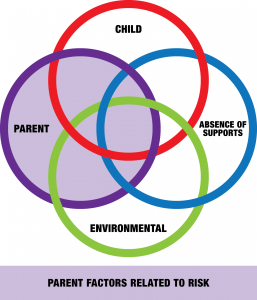
Psycho-Social Model
- Parent factors related to risk
- Child factors related to risk
- Environmental factors related to risk
- The absence of support increasing risk
Something from each of the four conditions needs to be present to cause a child to be abused.
The parent must have the predisposition to abuse their children.
They often experienced maltreatment in their own childhood.
They often have low self-esteem, feel unloved and uncared for, which affects all areas of their life, and relationships, including how confident and competent they are in parenting.
They lack trust in other people and will emotionally isolate themselves to avoid pain. This causes conflict in their relationships where outside sources of support and help are not available.
Parents who maltreat their children are often preoccupied with trying to find ways to get their own emotional needs met, and they often expect their children to meet those needs.
Abusive parents may look to their children to validate their self-esteem. They attribute the child’s behaviour as a rejection toward them rather than appropriately seeing it as natural behaviour related to the child’s age and stage of development.
Many (abusive parents) have poor emotional control, where they are volatile and prone to emotional outbursts.
They have unrealistic expectations of their children’s behaviour, increasing the likelihood of less understanding or patience with the child and perhaps being more punitive.
Both abusive and neglectful parents may exhibit a serious lack of empathy for their children (and a lack of understanding of their children’s developmental needs) where they mechanically perform caregiving without any warmth, sensitivity, or empathetic action (in response to the perceived needs of the child).
Some parents who have been raised with violence assume that violence is “natural.”
Both abuse and neglect may occur in families in which parents are mentally ill, developmentally challenged, or emotionally disturbed (however, the percentage of abusive or neglectful parents with disorders of this type is relatively small).
There is something in the parent’s life that has contributed to the caregiver’s predisposition to abuse the child.
Child Factors Related to Risk of Abuse:
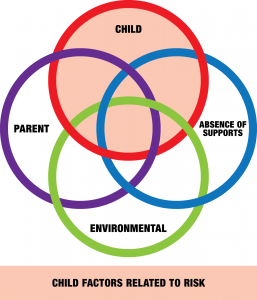
Psycho-Social Model
- Parent factors related to risk
- Child factors related to risk
- Environmental factors related to risk
- The absence of support increasing risk
Something from each of the four conditions needs to be present to cause a child to be abused.
Children who are perceived by their parents as different, abnormal, defective, or lacking in comparison to other children, are more likely to be victims of child maltreatment.
Child factors are not about a child’s wrongdoings and they are not about making children responsible for the abuse they experience due to their behaviour or event. Children are NEVER responsible for the abuse and NEVER deserve to be abused. The child’s condition or situation is about identifying the factors that increase the risk of abuse for children, particularly how the parent perceives the child in the situation. These factors include:
The parent believes that the child’s role is to behave and respond in ways to please and satisfy the parent;
Children are more prone to abuse if they cannot meet the parent’s expectations for “good” or “right” behaviour;
Some children are more difficult to care for due to their personality and temperament. This puts a child at a greater risk of being abused;
Children are at higher risk of abuse and neglect if they have a cognitive disability, mental health issues, conduct issues, learning disability, physical disability, hyperactive, premature, or chronic illnesses or medical conditions. These children often need continuous care, supervision and attention, which places excessive demands on their parents and increases the risk of abuse.
While abuse is possible for all children in a family, it is typical to find one child the target of most of the abuse. Children are at higher risk of maltreatment during specific developmental periods, e.g., infants requiring constant care or due to frequent crying and the toilet training stage, where there are power struggles and conflicts.
Characteristics of the child that the caregiver feels are difficult or different make them more challenging to care for, such as premature birth, birth trauma, unplanned, unwanted pregnancy, unsuccessful breastfeeding, adoption fantasy, foster-to-adopt dream, and step-child. The caregiver’s idea of what they thought was supposed to happen didn’t, and they struggled to bond with the baby increasing the risk of abuse.
The child is unwanted or does not meet the parent’s expectations; therefore, any behaviour the child exhibits is seen as out of the ordinary and perceived as demanding, challenging and a problem.
There is something about the child that the caregiver perceives as difficult or problematic, increasing the risk of abuse.
Environmental Factors Related to Risk of Abuse:
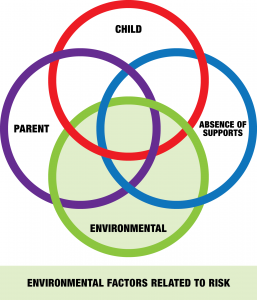
Psycho-Social Model
- Parent factors related to risk
- Child factors related to risk
- Environmental factors related to risk
- The absence of support increases risk
Something from each of the four conditions needs to be present to cause a child to be abused.
The precipitation of an abusive event is often related to excessive stress or a family crisis.
The parent may have difficulty dealing with stress due to poor coping skills (and low self-esteem).
There may be a significantly stressful event causing increased risk to children.
Unmanageable stress is often the “trigger” that precipitates an abusive event.
The size of the trigger depends on the number of parent and child factors contributing to the risk of abuse. If the parent has a large predisposition to abuse due to a significant number of factors along with numerous child factors, a small stressor can set off an abusive event. For example: running out of milk. The opposite is true if there are a few factors contributing to a predisposition. A large stressor is needed to trigger an abusive event.
High levels of chronic family stress may also contribute to neglect. For example, two years of COVID contributed to job loss, child homeschooling, financial loss, isolation and so on.
Absence of Support Increasing Risk of Abuse:
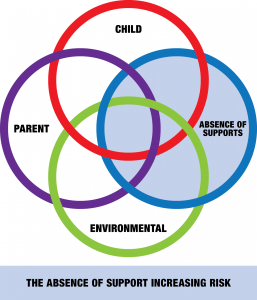
Psycho-Social Model
- Parent factors related to risk
- Child factors related to risk
- Environmental factors related to risk
- The absence of support increases risk
Something from each of the four conditions needs to be present to cause a child to be abused.
The unavailability of support and resources, or a family’s reluctance to access or utilize them, contributes greatly to maltreatment.
There are numerous reasons why a caregiver does not access support and resources, increasing risk. This can include a lack of availability and services, such as a remote northern community where counselling supports are hours away. Or cultural norms that one is not to share personal information outside of the family. This blocks a caregiver from accessing help. Supports and resources include agencies, institutions, organizations, community centres, child-care centres, schools, health care, mental health care and support, physical health care, and religious support, among support from family, friends, neighbours and community members. The ability to seek out and access support in the face of adversity is a protective factor to prevent and reduce the risk of child abuse. The lack of access, the lack of availability or the unwillingness to access support and resources in the raising of children, being in a relationship, coping and managing with life, work, family, extended family, work, finances and so on is a risk factor for child abuse. This can include:
Parents who are unwilling to reach out to other people for help, fear others or have an attitude it is “nobody’s business” cause isolation which prevents families from accessing support when needing help in coping with stressful situations.
Family conflict can impact a caregiver’s ability to seek support from extended family to help with child care, among other things increasing the risk of abuse due to conflict and lack of support.
Long waiting lists for helping resources that are affordable dissuade users from seeking support in the first place.
Accessibility of resources plays a role in whether people reach out to access them. For example, a community centre within walking distance from one’s home compared to one that requires a bus ride that is timely and costly.
Resources that are culturally specific, in the language of the end user’s preference, can play a role in whether someone reaches out to access support or not.
Cultural norms to not share personal problems outside the family home may prevent caregivers from reaching out for support.
Lack of trust and confidentiality in one’s community can prevent a caregiver from reaching out for help and support.
Intergenerational trauma may prevent a caregiver from reaching out for support to organizations in perceived positions of authority due to past and historical trauma.
Lack of knowledge of available supports may prevent a caregiver from accessing help such as a women’s shelter, increasing the risk of abuse.
Language barriers may prevent a caregiver from accessing knowledge about available resources.
The myth of self-sufficiency that a caregiver should be able to raise their children on their own. They had the child; they should have an innate understanding of what children need and be able to provide and manage those needs. “You’re a mom, you should know.” Holding on to these beliefs can prevent a caregiver from reaching out for support, increasing the risk of abuse.
Racism can prevent a caregiver from reaching out for support. Racism is a barrier to accessing support when a caregiver experiences judgment, and hostility, is not believed or is even turned away. These real-life experiences become the fabric of the community preventing people of diverse cultural backgrounds to reach out for help.
Absence of Supports
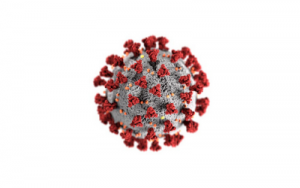
Absence of Supports increases the risk of abuse. No access to supports during the global pandemic increased the risk of abuse.
The global pandemic closed all access to resources and supports which increased the risk of child abuse. Parks were taped off, children were not allowed outside, physical schools were closed, recreation facilities were closed, sports activities were stopped, and children began online education in unprecedented isolation. Support and resources for families were not available.
One’s sexual orientation can prevent someone from reaching out for support. The belief that they will not be safe or respected is a profound motivator to keep what is happening private and prevents a 2SLGBTQIA+ person from reaching out for help, or a transgender person seeking support when they feel they will be judged and unsafe, so they don’t try. Both of these scenarios increase the risk of abuse.
One’s personal religion or religious affiliation may prevent caregivers from seeking support outside of the church. If the circumstances don’t change within the family and the support from the church does not help, the risk of abuse increases. The church can be helpful in some situations. It can be harmful if the right kind of support is not offered.
Fear of the Children’s Aid Society can prevent a caregiver from reaching out to access support. Someone who recognizes that they need help, perhaps things have gone too far, may feel overwhelmed with fear that their children will be taken away. This prevents the caregiver from accessing support, increasing the risk of abuse.
A lack of knowledge and understanding about the role of the Children’s Aid Society (CAS) prevents the caregiver from reaching out for help. The caregiver believes that CAS would apprehend their children if they knew what is happening in the child’s life. When in fact, the CAS’s primary purpose is to promote the well-being and best interests of the child, including protection. In most situations, this means leaving the children with their caregiver and assisting the caregiver to be a better parent.
Lack of community investment in infrastructure to support families and children. Without the needed recreational places for families and children, such as parks and playground equipment, community centres, ice rinks, swimming pools, basketball courts, low and no cost children’s activities, risk of child abuse increases.
When assessing for risk of abuse, apply Steele’s Psycho-Social theory by identifying all the parent factors supported with evidence that contribute to the risk of child abuse. Then identify all the child factors supported with evidence that increase the risk of the child being abused. With the environmental factors, identify all the stressors in the family, supported with evidence of increasing the risk of abuse. Last, identify what resources the caregiver has accessed or not. Where possible, label the caregiver’s thoughts, feelings, and attitude toward help and support.

